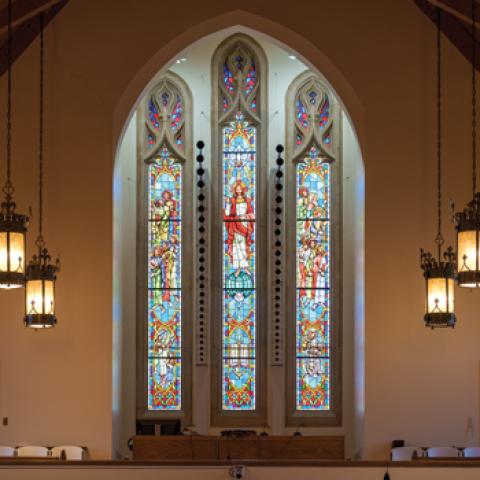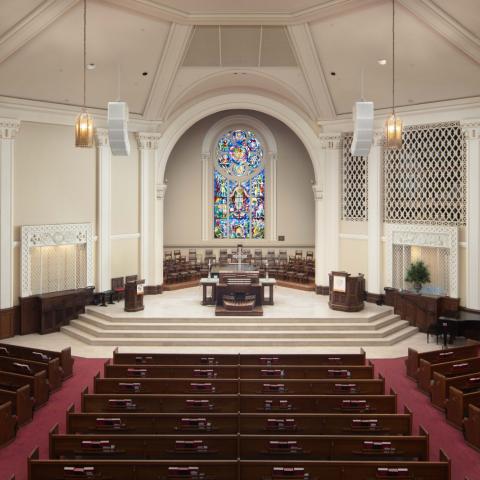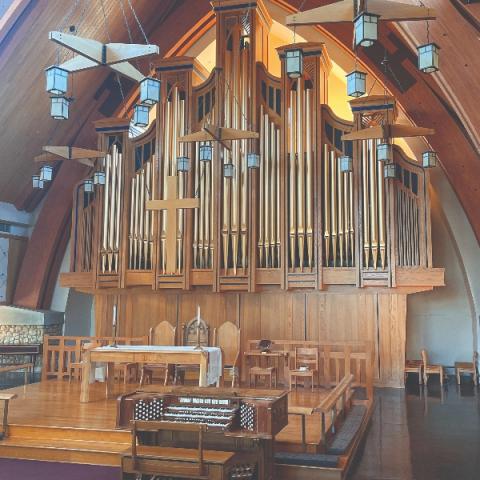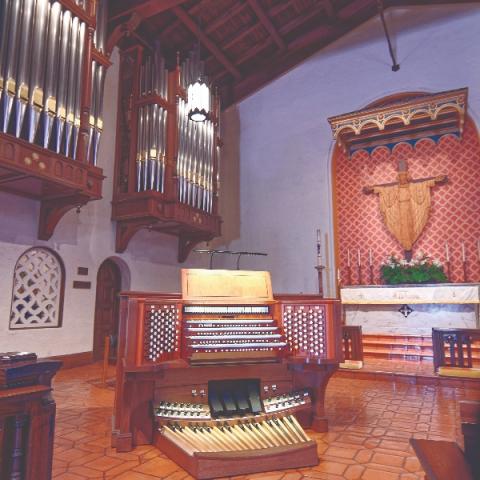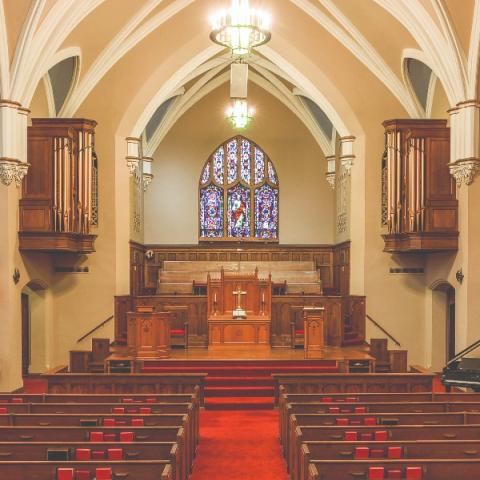Lewtak Pipe Organ Builders, Mocksville, North Carolina; Haymount United Methodist Church, Fayetteville, North Carolina

In our previous cover features in The Diapason and The American Organist, we exclusively showcased our own work. However, this time, we aim to spotlight another crucial aspect of our business endeavors—high-quality organ renovations and additions to existing instruments. These projects constitute nearly half of our workload and are just as essential to us as our new builds.
The importance of preserving our cultural heritage is undisputable. The pipe organ plays a particularly prominent role in the modern history of human civilization. For centuries, its majestic sound has inspired us, its external beauty has dazzled, and its technical complexity has astonished all who have had the chance to explore its inner workings. There is a good reason why the organ bears the title of the King of Instruments—no other instrument has the ability to fill vast interiors of even the largest buildings with sound that can transition from a shimmer to thunder with ease and grace. The pipe organ is truly an awe-inspiring instrument!
For these reasons, we undertake renovation projects with great joy and reverence. It is both a duty and a privilege. Naturally, it is our responsibility to care for instruments built by others, with the hope that someday someone else, younger and more capable, will care for the ones we built. But renovating is also a treat in a way that only technical buffs can understand—there is always so much to learn and explore. Human ingenuity never fails to inspire, and in the process of discovering someone else’s work, we benefit from their wisdom and creativity. Through many years of working on different organs, we can say with absolute certainty that each time is a humbling experience. Repairing these complex instruments requires a labor of love and dedication.
But the same requirement is placed upon the owners of these instruments. It takes love and dedication to commit to the renovation process, one that very often carries a significant price tag and necessitates sacrifices from the entire faith community. It takes vision, determination, and great organizational skills to carry out a project that, let’s face it, is rarely at the top of the list of priorities. These exact traits were evident at Haymount United Methodist Church in Fayetteville, North Carolina, where the strong-willed members of the congregation made it possible to breathe new life into a magnificent organ from the now-extinct M. P. Möller organ factory.
The organ at Haymount United Methodist Church was built as Möller’s Opus 11011, completed in late June of 1975. During its nearly fifty years of service to this church, the instrument underwent several planned additions and necessary updates. Among the most significant changes was the installation of an electronic organ control system, which replaced the outdated and cumbersome original electro-pneumatic equipment inside the console. However, this update did not stand the test of time. Rapid advancements in the electronic industry rendered the old system obsolete and incapable of meeting the requirements of modern performance. Additionally, the leather components were reaching the end of their lifespan and began to show signs of trouble, manifesting in dead notes, ciphers, and unresponsive ranks. It became evident that a comprehensive solution was needed—a total renovation and overhaul of the entire organ.
During the planning stages of the renovation, a surprising idea emerged—the addition of a horizontal trumpet. Not just any trumpet, but a high-pressure en chamade trumpet requested by the client, positioned on the opposite side of the church to effectively project its sound through the full volume of the chancel organ. The only logical placement for this feature was at the back of the nave, between the stained-glass windows, necessitating an unusual configuration of the en chamade in two vertical rows. Nonetheless, we welcomed these challenges with enthusiasm.
By the end of 2019, the contract was signed, and we were preparing to commence work sometime in the middle of 2020. However, unforeseen circumstances arose—the pandemic disrupted our plans entirely. Life as we knew it ground to a halt across the United States and beyond. Our workshop was mandated to close for several months as a “non-essential business,” and our suppliers halted the provision of necessary parts due to the same circumstances and shortages. Despite these formidable obstacles, we resolved to press ahead with the renovation, buoyed by the unwavering support of the church in making this decision.
The renovation at Haymount United Methodist Church was truly comprehensive, leaving no detail overlooked. Every aspect of the organ received scrupulous attention, ensuring its restoration to peak performance. Bellows were carefully removed and underwent complete refurbishment at our state-of-the-art workshop. Approximately 2,000 leather pouches in the windchests were replaced with new pneumatics. All pipes underwent cleaning, repair, voicing correction, and precise reinstallation.
The console underwent a thorough transformation in our workshop, being stripped down, refinished, and outfitted with new electronics, drawknobs, pistons, LED lights, and an updated electronic system interface. The existing keyboards, crafted with ivory and ebony, along with the pedalboard, were restored to mint condition. We upgraded the entire switching system from analog to digital, implementing optical sensors for all keyboards and the pedalboard, and transitioning communication between the console and organ chamber to a fiber-optic network.
Reed pipes received meticulous attention, undergoing cleaning of the reeds and shallots, while wooden pipe stoppers were repacked with fresh leather. Existing swell shade motors were re-placed with new electronic operators by Peterson. Alongside numerous repairs, we introduced several new components, including a brand-new adjustable-height bench for the console and a redesigned music rack made from tempered glass.
Two new high-pressure blowers were installed, one for the Trompette de Gabriel (en chamade) and another for the Festival Trumpet. Additionally, we constructed a new Zimbelstern, featuring sixteen bells with adjustable speed.
Crucially, we replaced the existing organ control system with a new one from Matters Inc., which offers an array of features tailored to the organist’s needs, such as record/playback, transpose, MIDI capability, unlimited memory levels, and programmable crescendos. This system is characterized by its robustness, speed, reliability, and ease of installation and future servicing.
Following a period of fine-tuning and adjustments, the organ resumed serving the faith community of Haymount United Methodist Church in June of 2021, embodying a renewed spirit and enhanced capabilities.
The entire team at Lewtak Pipe Organ Builders extends our heartfelt gratitude to the members of Haymount United Methodist Church for their steadfast support and confidence in our craftsmanship. This project has been challenging, but the outcomes are sure to instill pride in the community for years to come.
—Tom Lewtak
Photo credit: Kacper Lewtak
M. P. Möller Opus 11011 (1975)
GREAT (Manual II, exposed)
16′ Gemshorn 61 pipes
8′ Principal 61 pipes
8′ Bourdon 61 pipes
8′ Gemshorn (ext 16′) 12 pipes
4′ Octave 61 pipes
2′ Super Octave 61 pipes
Fourniture III–IV 220 pipes
8′ Trompete 61 pipes
8′ Festival Trumpet 61 pipes
8′ Trompette de Gabriel 49 pipes (new, en chamade, 50–61 repeat)
Great Unison Off
Great 4′
Chimes 21 tubes
POSITIV (Manual I, enclosed)
8′ Geigen Principal (TC) 49 pipes (1–12 Gemshorn 8′)
8′ Holzgedeckt 61 pipes
8′ Flauto Celeste (TC) 49 pipes
4′ Spitzflöte 61 pipes
2′ Prinzipal 61 pipes
1-1⁄3′ Quint 61 pipes
Zimbel III 183 pipes
16′ Dulzian 61 pipes
8′ Krummhorn 61 pipes
Tremolo
8′ Festival Trumpet (Great)
8′ Trompette de Gabriel (Great)
Positiv 16′
Positiv Unison Off
Positiv 4′
SWELL (Manual III, enclosed)
16′ Flûte à cheminée 61 pipes
8′ Flûte à cheminée (ext 16′) 12 pipes
8′ Viole de gambe 61 pipes
8′ Viole celeste 61 pipes
4′ Prestant 61 pipes
4′ Flûte à fuseau 61 pipes
2-2⁄3′ Nasard 61 pipes
2′ Flûte à bec 61 pipes
1-3⁄5′ Tierce 61 pipes
Plein Jeu III–IV 220 pipes
16′ Basson 61 pipes
8′ Trompette 61 pipes
8′ Basson (ext 16′) 12 pipes
8′ Voix Humaine 61 pipes
4′ Clairon 61 pipes
Tremolo
8′ Trompette de Gabriel (Great)
Swell 16′
Swell Unison Off
Swell 4′
PEDAL
32′ Violone (digital)
16′ Contrebasse 32 pipes
16′ Subbass 32 pipes
16′ Gemshorn (Great)
16′ Flûte à cheminée (Swell)
8′ Octave (ext 16′) 12 pipes
8′ Gemshorn (Great)
8′ Flûte à cheminée (Swell)
4′ Choralbass 32 pipes
4′ Flûte à cheminée (Swell)
Mixture III 96 pipes
32′ Basson (digital)
16′ Posaune 32 pipes
16′ Basson (Swell)
16′ Dulzian (Positiv)
8′ Trompette (ext 16′) 12 pipes
8′ Trompette de Gabriel (Great)
4′ Basson (Swell)
Inter-divisional couplers
Great to Pedal 8′
Swell to Pedal 8′
Swell to Pedal 4′
Positiv to Pedal 8′
Swell to Great 16′
Swell to Great 8′
Swell to Great 4′
Positiv to Great 16′
Positiv to Great 8′
Positiv to Great 4′
Great to Positiv 8′
Swell to Positiv 16′
Swell to Positiv 8′
Swell to Positiv 4′
Combinations
Great-Positiv Transfer
General pistons 1–10
Divisional pistons 1–5, all manuals and pedal
Set, Cancel, Tutti, Next, Previous, Zimbelstern, Sequencer On/Off
Console
Existing console shell completely restored to mint condition
Existing keyboards with ivory/ebony tops completely restored
Existing pedalboard completely restored
New organ bench with adjustable height
New music rack, tempered glass with laser etched Möller and Lewtak logo
New music rack, coupler rail and pedalboard LED dimmable lights
Swell and Positiv expression shades LED indicators
Mechanical and electrical
Electronic organ control system by Matters Inc. with unlimited memory levels, internal Record/Playback, and MIDI capability
Fiber-optic communication connection between console and organ chamber/en chamade
New high-pressure blower and winding system for the en chamade 8′ Trompette de Gabriel
New high-pressure blower and bellow for the 8′ Festival Trumpet
New custom-built Zimbelstern with 16 bells
New swell expression motors, 8-stage, by Peterson
New power switching system for the entire organ
New internal power supply for Walker Paradox System
Tuning, temperament, wind
Equal temperament
A=440 HZ at 19 degrees Celsius
Thirteen single-rise bellows, various sizes, all completely refurbished or manufactured new
Wind pressure:
Great, Positiv and Pedal at 2.75 inches
Swell at 3 inches
55 stops
46 pipe ranks + 2 electronic
2,579 pipes

